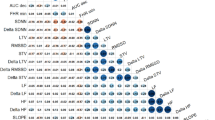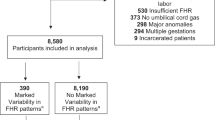Abstract
OBJECTIVE:
To compare the predictive abilities, test duration times, and incidence of nonreactive results in the acoustic stimulation test (AST) and the nonstress test (NST).
METHOD: Four-hundred randomly selected patients, delivering within 7 days of a preceding test, were divided into two groups (group I: NST; group II: AST). In the AST group, fetal heart rate tracings were recorded for the first 5 minutes as a baseline recording. If the reactivity criterion was not met, transabdominal acoustic stimulation to the fetal head was performed. In the NST group, nonreactive tests were followed by a repeat NST. In both groups, nonreactive tests were followed by oxytocin challenge test (OCT) on the same day. Depressed 5-minute Apgar scores (<7) and an umbilical arterial blood pH of <7.2 were taken as indicators of fetal distress. Sensitivity, specificity, and predictive values of NST and AST were calculated and compared.
RESULTS:
The incidence of nonreactive tests was lower in the AST group. AST decreased the test duration time by 10.1 minutes. The sensitivity values were 87.5% in the NST group and 85.7 in the AST group; specificities of were found to be 94% for AST and 88% for NST. The negative predictive value was found to be 98% in each group, but the positive predictive value was 54.5% in the AST group and 38.8% in the NST group.
CONCLUSION: AST offers benefits, by decreasing the incidence of nonreactive tests and reducing the test time. AST lowers the rate of false positives without changing the negative reliability of NST. It is a safe test and allows more efficient use of perinatal services.
This is a preview of subscription content, access via your institution
Access options
Subscribe to this journal
Receive 12 print issues and online access
$259.00 per year
only $21.58 per issue
Buy this article
- Purchase on Springer Link
- Instant access to full article PDF
Prices may be subject to local taxes which are calculated during checkout
Similar content being viewed by others
Author information
Authors and Affiliations
Rights and permissions
About this article
Cite this article
Saraçoğlu, F., Göl, K., Şahin, İ. et al. The Predictive Value of Fetal Acoustic Stimulation. J Perinatol 19, 103–105 (1999). https://doi.org/10.1038/sj.jp.7200135
Published:
Issue Date:
DOI: https://doi.org/10.1038/sj.jp.7200135
This article is cited by
-
Evaluation of the effects of acoustic stimulation and feeding mother stimulation on non-reactive non-stress test: a randomized clinical trial
Archives of Gynecology and Obstetrics (2013)



